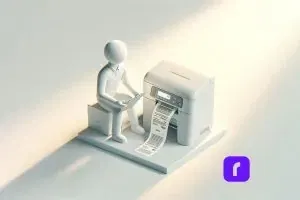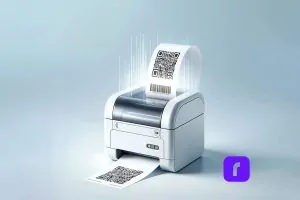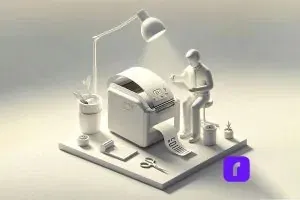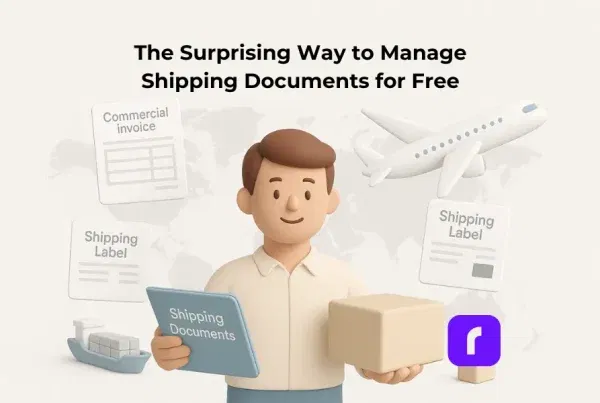All types of companies need good label printing to keep their operations running smoothly. Investing in a commercial label printer delivers versatility, efficiency, and savings – key pillars that set businesses up for success.
This guide will explore everything you need to know, from the technologies powering modern label printers to practical factors like maintenance and integration. Read on to make an informed decision in choosing the right labeling solution for your evolving business needs.
Did you know? 🤔 Did you know that efficient label printing can reduce operational costs by up to 30% for businesses?
Understanding Commercial Label Printers
Before we dive into specific features, let’s clearly define what a commercial label printer is and how it differs from a regular home or office printer.
What is a Commercial Label Printer Used For?
Designed for high-volume label printing needs, commercial label printers empower businesses to efficiently create product labels, shipping labels, barcode labels, packaging components, signage, and much more in-house. This eliminates reliance on third-party printing services.
Common applications include:
- 📦 Product and inventory labeling
- 🚚 Shipping and postage labels
- 📊 Barcode and QR code generation
- 📦 Boxes, bags, and packaging printing
- 🎁 Promotional and gift labeling
- 🎉 Event materials and signage
- 🏥 Patient record labeling in healthcare
- 💻 Asset tracking and IT equipment tagging
- 🌟 And countless other uses
With on-demand printing capabilities measured in thousands of labels per day, investing in the right commercial equipment brings labeling operations entirely under your own control.
Commercial vs Regular Label Printers: Key Differences
While regular document printers found in most offices allow basic label printing, commercial label makers are in a class of their own. Built for business, commercial printers offer:
- 🏭 Industrial-grade production: Print up to thousands of labels per day with speeds exceeding 5 inches per second. Regular printers max out at a few dozen per day.
- ⚙️ Advanced functionalities: Features like automatic cutters, peel & present mechanisms, and label rolls ensure smooth high-volume printing. Most basic printers lack these capabilities.
- 🔩 Durable parts designed for constant use: Expect a minimum 5-year lifespan supported by solid warranties – far longer than the lifespan of a regular printer.
- 🔄 Flexibility: Print on a wide array of label materials and sizes exceeding well beyond address or shipping label capabilities on conventional printers.
- 🔍 Precision and consistency: Get sharp, detailed prints even at small font sizes thanks to advanced printing technologies exceeding 600 or 1200 DPI resolution.
Pick a label printer that handles your business’s current and future printing volumes. It should grow with your company rather than limit it. Buying a higher-capacity printer now saves money later on. The long-term savings make the initial investment worthwhile for most small and large businesses.
⚠️ Keep in mind While exploring commercial label printers, it's crucial to consider not just the initial cost but also the printer's compatibility with various label materials and technologies. This ensures your chosen solution can adapt to future labeling requirements and industry trends, maximizing your investment's value over time.
Technologies and Features Behind Commercial Label Printers
Modern commercial label printers leverage innovative technologies to deliver versatile, high-quality printing with precision and efficiency. Let’s explore some of these technologies empowering businesses daily:
Innovative Printing Technologies
Industrial label printers rely on thermal, inkjet or laser technology to transform blank label materials into professional-grade items. Highlights include:
- 🔥 Thermal Printing: Uses heat to transfer images onto thermally sensitive labels, delivering sharp and consistent results cost-effectively. Ideal for shipping labels, product labels, healthcare, and more.
- 💧 Inkjet Printing: Squirts tiny ink droplets creating images directly onto the label surface. Delivers vibrant multi-color printing. Best suited for high-detail promotional, gift, and retail labeling applications.
- ⚡ Laser Printing: Uses electrostatic charges and toner to fuse print onto labels, similar to how office copiers work. Allows printing on specialty label stocks. Ideal for durable goods and manufacturing labeling.
Start Commercial Label Printing.
Efficiently, Fast, Eco-friendly.
Commercial label printers now come in thermal, inkjet, or laser technologies. Prioritize color needs, print quality, material flexibility, and printing volume when choosing the best technology for your business.
PRO TIP: When evaluating the technologies and features behind commercial label printers, consider printers with scalable resolutions. Printers offering adjustable DPI (dots per inch) settings provide flexibility for various applications, from high-detail graphics for promotional labels to simple, clear text for shipping labels. This adaptability ensures your printer can meet diverse printing needs as your business evolves.
Versatility in Materials and Designs
The materials your business prints on depend entirely on the application and product. Modern commercial label printers offer versatility in handling:
- 📄 Paper and synthetic labels like matte, high-gloss, or polyester options.
- 🛡️ Specialty label materials including weatherproof, security, high-temperature, metallic, magnetic stripes, and more.
- ✨ Different label finishes from frosted to reflective – all popular in gifts, retail, and food packaging.
- 🔲 Various label shapes and sizes like round, rectangular, or die cut.
These printers use design software for printing text, numbers, barcodes, tables, diagrams, and images onto labels.
This equates to endless labeling possibilities allowing customization to new products, changing regulations, and evolving business needs.
Connectivity for Modern Business Needs
Many businesses now store data in the cloud. So label printers need to connect to these centralized systems. Most commercial printers easily plug into:
- 🔌 USB: Simple plug-and-play connectivity to individual computers.
- 🌐 Ethernet: Wired network connectivity for access by multiple devices.
- 📶 Wi-Fi: Wireless network connectivity centrally managed through infrastructures.
More advanced network management protocols like SNMP allow deeper integration with business networks and systems.
How To Select the Right Commercial Label Printer
Label printer technology keeps improving quickly. So the printer you need today may not fit your future business growth. But considering a few key factors allows you to make a printer investment that scales up with your company’s expanding needs:
Key Consideration Factors
Assess requirements across three key areas – volume, materials/purpose, and connectivity:
- 📈 Current and Expected Volume: Print speed, duty cycle, and input label roll size must match usage levels. Thermal printers handle most moderate-volume labeling needs, with inkjet and laser stepping in for 24/7 production.
- 🏷️ Label Materials and Purpose: The label stock, ink/toner durability, resolution, and colors dictate which print technology is best suited. Consider end-use when prioritizing criteria.
- 🌍 Networking and Connectivity: More networked environments benefit from centrally connected printers with protocols like SNMP allowing deeper integration with systems.
While upfront cost drives most purchase decisions, don’t let that be the dominant factor. An undersized label printer incapable of growing with your business turns out far more expensive long-term.
Did you know? 🤔 The rise of smart labels with RFID and NFC technology allows for real-time tracking and consumer engagement. Even address labels Amazon uses now are incorporating these smart technologies. This trend towards digital printing also supports small batch and personalized label production. When choosing a label printer, consider one that accommodates these advanced features to future-proof your investment.
Cost Considerations and Calculating ROI
The printer itself represents only one piece of the investment. Ink, toner, label materials, maintenance parts, and possible downtime also add up over years of ownership.
Consider:
- 💸 Operational Costs: Factor around 2 years of ink/toner, labels, and parts into cost projections when comparing models. Cheaper printers have higher long-term running costs.
- 💰 Value Over Lifespan: Given 5+ year lifecycles, a commercial label printer costing more upfront often saves money over the long run through efficiencies.
- ⚖️ Scalability: Weigh if capabilities accommodate reasonable business growth without requiring whole replacements after just 1-2 years.
When you calculate costs over the several-year lifespan of a commercial printer, you always save money by printing in-house instead of outsourcing. You also gain efficiency and can respond faster to customers.
Advanced Applications to Enhance Business Functions
Beyond everyday shipping and inventory labels, modern commercial printers empower advanced applications:
Barcode and QR Code Printing
A commercial barcode printer for labeling streamlines inventory management and shipping by allowing tracking through production, warehouse storage, final mile delivery, and even customer use.
Most commercial label printers seamlessly integrate with barcode label design software for printing scan-readable UPC, QR, and other codes. RFID smart labeling takes it a step further by actively tracking goods.
This brings simplicity where spreadsheets and manual tracking once created headaches.
Eco-Friendly Printing
Sustainability in labeling influences everything from materials used to energy efficiency of printers, and responsible disposal/recycling.
Many modern commercial printers adopt eco-conscious practices like:
- ♻️ Recycled label materials using post-consumer waste content.
- 🌱 Soy-based inks replacing oil-based options.
- 💡 Energy efficiency reduces power consumption, sometimes by 40% or more.
- 🔄 Responsible recycling programs to keep printer components out of landfills.
Decisions like opting for thermal printing and only printing what’s essential further minimize environmental footprints.
⚠️ Keep in mind As you delve into advanced applications to enhance your business functions, remember that the integration capabilities of your commercial label printer with existing systems and workflows are just as important as its technical features. Ensuring seamless connectivity can significantly streamline operations and boost efficiency.
ENHANCE BUSINESS FUNCTION WITH ROLLO SHIP.
The first 200 shipping labels (commercial shipping labels) are on us.
Every next label is just 5 cents.
Schedule pickups, consolidate orders, and print bulk labels.
Up to 90% off UPS, FedEx, and USPS shipping.
Maintaining and Troubleshooting Commercial Label Printers
Commercial label printers last longer than regular office printers. But taking good care of them extends their life and keeps them performing well.
Maintenance Tips
Follow some basic usage and maintenance guidelines to keep printers in top shape:
- ✅ Use only approved label materials to avoid jamming and wear.
- 🧹 Schedule periodic cleaning using compressed air, lint-free cloths, and cleaning cartridges.
- 🛠️ Follow manufacturer-recommended maintenance schedules to replace key components like printheads before they fail.
- 🔄 Keep firmware and drivers updated to maximize performance and fix bugs.
- 🧽 Clean out dust and label fragments before buildup impairs printing.
Respecting simple precautions goes a long way to enjoying years of trouble-free operation.
Software Integration
While all commercial label printers include basic design software, third-party programs integrate tightly to boost capabilities.
Learn all about Rollo’s shipping integrations for e-commerce platforms, marketplaces, and major shipping carriers.
Specialty software helps make the most of commercial printers. Programs for specific barcodes, hazard labels, graphics, and data help get the full value from the printers.
Look for label software that delivers:
- 🔗 Compatibility with major printers to avoid limitations. Web-based apps offer wider support.
- 📊 Barcode generation with verification checks to confirm scanability.
- 🎨 Graphics libraries for logos, icons, and images to enhance visuals.
- 🖥️ CSV/database connectivity for printing serialized variable data.
- 🧙♂️ Template design wizards speeding up common label jobs.
- ✅ Certified compliance templates meeting regulatory mandates.
While built-in and free label software works for basic needs, commercial solutions speed up specialized labeling projects.
Troubleshooting Common Printer Issues
Like any device, label printers can have jams, feeding problems, or low ink warnings. But knowing basic troubleshooting fixes most issues.
- 🚫 Misfeeds or jamming – Gently remove labels and fragments causing obstructions. Avoid tearing the label material and use caution around heated printheads.
- 🧽 Streaking/Fading Print – Clean printheads and platen rolls according to cleaning instructions. Replace worn parts as needed.
- ⚙️ Sync Errors – Update printer and computer software if you see blinking lights or uneven printing.
- 🌐 Network Issues – With cloud-connected printers, check wires, reboot wifi, or set static IPs to fix connection problems.
Following factory-prescribed maintenance, using approved media, and avoiding label fragments/dust build-up minimizes problems. Refer to manufacturer guides for step-by-step troubleshooting advice on any specific models in use.
PRO TIP: Regularly calibrating your commercial label printer can significantly reduce the chances of print errors and misalignments. This simple maintenance step ensures consistent quality and efficiency, saving time and resources by minimizing the need for reprints and adjustments. Always refer to your printer's manual for specific calibration instructions to keep it operating at peak performance.
The Future of Commercial Label Printers
While meeting today’s demands, commercial printers continuously adopt the latest technology innovations to deliver more value:
Emerging Printer-Side Innovations
- 📊 Embedded sensors monitor printer health stats for preventative alerts and predictive maintenance.
- 🌍 Expanded connectivity protocols allow managing fleets of dispersed printers from a central dashboard.
- 🤖 Automated maintenance performs prescribed cleaning and upkeep without user intervention.
- 🕶️ Augmented reality-enabled printers integrate with smart glasses for diagnoses and troubleshooting guides projected virtually in the field of vision.
Label & Material Advancements
- 📡 RFID smart tags transform standard labels into micro-networked trackers relaying data to enterprise systems.
- 📱 NFC (near-field communication) allows tap-scanning labels with mobile devices to pull up detailed information.
- 🌡️ Smart labels change visual properties by reacting to temperatures, tampering or other states.
- 🛡️ Highly durable specialty label materials expand the range of printable surfaces from textiles to electronics.
Tighter Infrastructure Integration
- 🔗 APIs and instant platform integration allow embedding label printing capabilities into eCommerce sites, mobile apps, ERP systems, and custom software.
- ⚙️ End-to-end automated workflows tie together enterprise data, custom-designed labels, validated output, and multilayered business logic for integrated processes not previously possible.
Did you know? 🤔 According to a recent report by Smithers Pira, the future of label printing looks bright, with the market expected to grow from $39.46 billion in 2018 to a staggering $49.90 billion by 2024, marking a growth rate of 4.0%. This significant increase highlights the evolving demand and technological advancements in the label printing industry.
Final Words: The Key to Maintaining Efficiency
An investment in the right commercial label printer today pays dividends through years of use, only seeing returns multiply as labeling needs grow over time.
⚠️ Keep in mind In your journey to select the right commercial label printer, remember that this decision is not just about addressing current needs but also about anticipating future demands. Investing in a versatile and scalable printing solution will serve your business well into the future, supporting growth and adapting to evolving market trends.
While next-generation technology holds exciting potential, even current affordable and capable options deliver value, safety compliance, customer responsiveness, and sustainability – all central to staying competitively efficient in this modern economy.
Hopefully, this guide provided helpful insights into the full lifecycle around selecting, using, and maintaining industrial label printers optimized for the unique needs of your business.
What label printing technology does your business currently use? Share your experiences or questions below!
Follow Rollo on:
Frequently Asked Questions about Choosing The Right Commercial Label Printer:
📌 Q: What factors should I consider when choosing a commercial label printer?
💭 A: Consider print volume, label material compatibility, print technology (thermal, inkjet, or laser), connectivity options (USB, Ethernet, Wi-Fi), and future scalability to ensure the printer meets both current and future needs.
📌 Q: How do I decide between thermal, inkjet, and laser label printers?
💭 A: Thermal printers are ideal for most businesses due to their cost efficiency and reliability for continuous label printing. Unlike inkjet printers, which require frequent ink purchases, and laser printers, known for their high initial costs and energy use, thermal printers offer a more economical and sustainable solution for producing high-quality labels without the extra expenses.
📌 Q: Can commercial label printers integrate with my existing business systems?
💭 A: Yes, many modern label printers support various connectivity options and protocols like SNMP for integration with business networks, ERP systems, and cloud-based platforms, enhancing workflow efficiency.
📌 Q: What maintenance is required to keep a commercial label printer in good condition?
💭 A: Regular maintenance includes using approved label materials, periodic cleaning with compressed air and lint-free cloths, following the manufacturer’s maintenance schedule for component replacement, and keeping firmware and drivers updated.
📌 Q: How can I calculate the ROI of investing in a commercial label printer?
💭 A: Consider the initial purchase cost, operational costs (ink, toner, labels, maintenance), and potential savings from in-house printing versus outsourcing. Factor in efficiency gains, reduced downtime, and the ability to quickly respond to labeling needs, which can significantly impact ROI.






